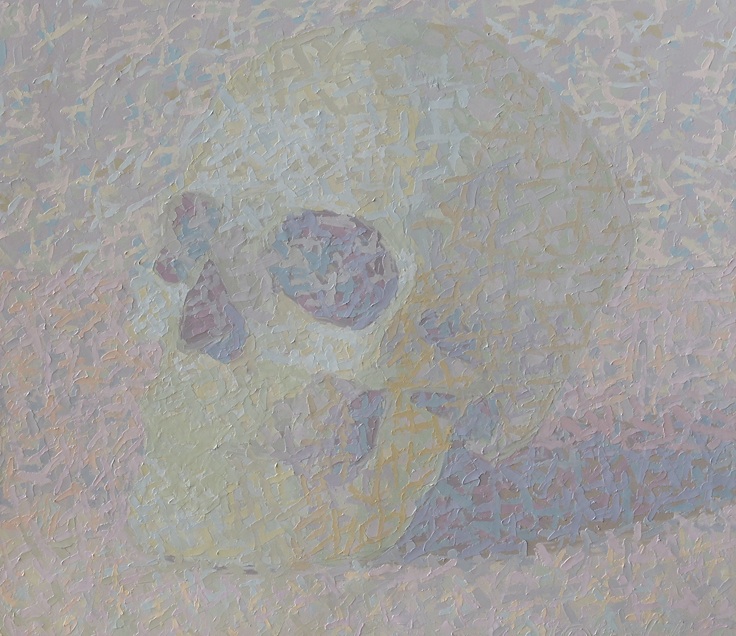Fields of color
At our recent lunch, Rick Harrington reminded me of David Oleski’s work, and I returned to it, at his website, with pleasure. It’s gotten more subtle and complex in execution, and yet in a way even simpler in its effect, than when I looked a few years ago. It’s a remarkable way to start with Impressionism, especially Monet and Seurat, and somehow also evoke work from a century, as well, finding a home that somehow seems to link Mark Tobey with Morandi. I dread most greens, but he appears to have devoted countless hours to finding new ways to see that color. I like how his areas of color seem to sit quietly and stay where they are, without any sense that one area of paint is moving toward another, no hint of gesture, as if a realistic image of a pear has settled into simpler patterns, all the details disappearing like sediment into a map of peach, green, yellow, and ochre. It’s a mystery how he breaks up what he sees into the cross-hatches he’s trying now. His statement, below, suggests that he contends with something I’ve encountered–that many potential collectors see his work as decorative, since it’s beautiful and devoid of metaphoric content. It’s all perceptual, but that doesn’t mean it isn’t an attempt to give vision a resonance that evokes something like wisdom and joy. It would look great in a room, but that doesn’t mean it’s decor. I like, in his statement, he talks so much about craft and materials.
I came to the realization that many people don’t really understand what it is that I do. I paint in oils, on stretched linen. These are the same materials used by some of the greatest painters throughout history, from Monet and Van Gogh to Rembrandt and Valesquez. I use non-yellowing linseed oil, and a non-yellowing white, so the colors will not darken with age, even after a century. I paint on the highest quality Belgian linen, which is stronger and will not become permanently stretched and loose like cotton canvas, and is more resistant to bacterial growth.
Next, read about my frames.

This is one of my frames. I have these custom made at a frame shop in north Philadelphia. They’re a dark cherry-stained poplar, and the corners are joined with splines for the strongest and cleanest joint possible. The final clear coat is a satin finish, to best showcase the tight grain of the wood. The frames have a three quarter inch face, and are two inches deep. Every painting I finish is framed with one of these fine pieces of woodwork.
I work on only one painting at a time, working continuously for session after session until it’s finished, and then I’ll use the back end of a brush to scratch my name and the date into the wet paint on the lower right corner. I only work from observation. When I paint apples, there are apples in front of me, when I paint tulips, I’m looking at a bouquet of tulips, and I’m racing against the flowers blooming and wilting with each passing day. I only work by natural light, so I have to calculate my sessions to either finish by sunset, or plan on another session. This process dictates that the painting will always be about observation, and I will always strive to capture how I see, not merely create a painting. The way I work is very thorough and meticulous, to match each color of a still-life and lay it down in a very specific and calculated manner. This is how I learned to paint in art school, and I continue to learn more and more about space and depth and atmosphere with each study that I finish.
All I do is paint, every day, bordering on it being an obsessive/compulsive disorder to either fixate on the current painting or obsess over starting the next one. This is all I do, every single day. My prices have steadily increased every year to maintain demand and assure the investment value of my work to my current and past clients. All poetic reflection aside, I believe what I do is valid and substantial in the eyes of history, and I’m creating a legacy that will live on for many years after I am gone.

Comments are currently closed.